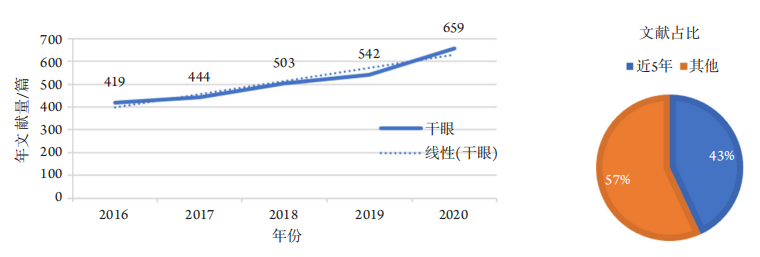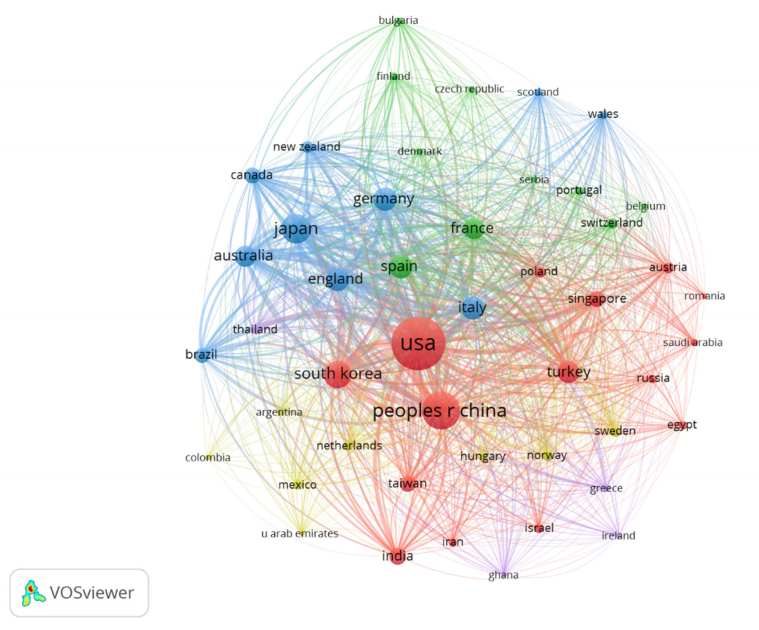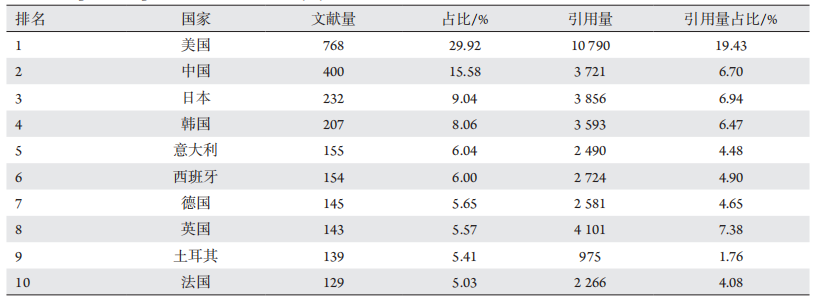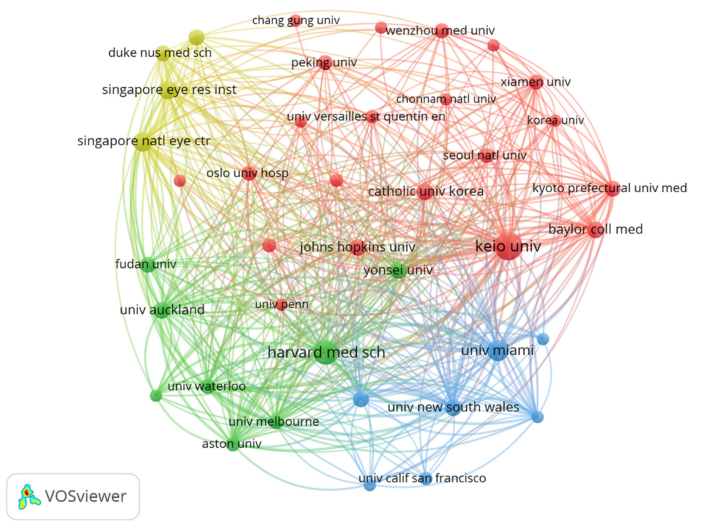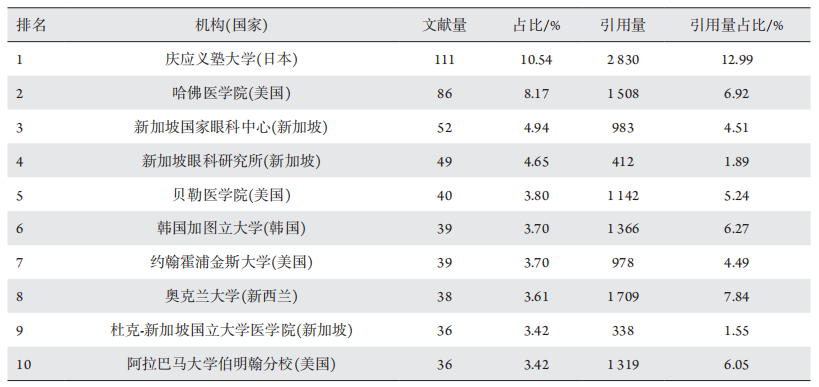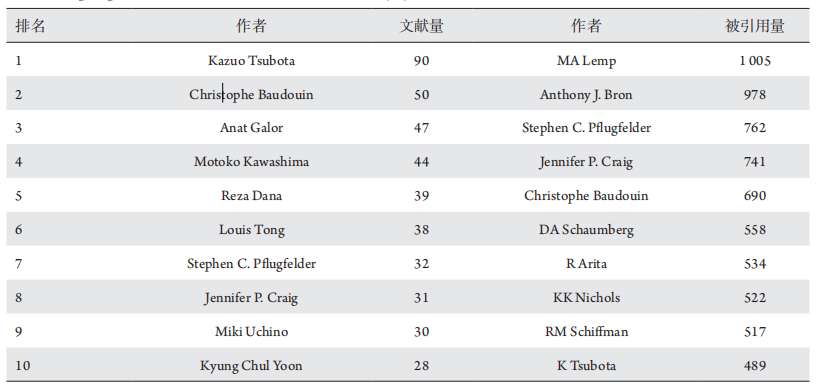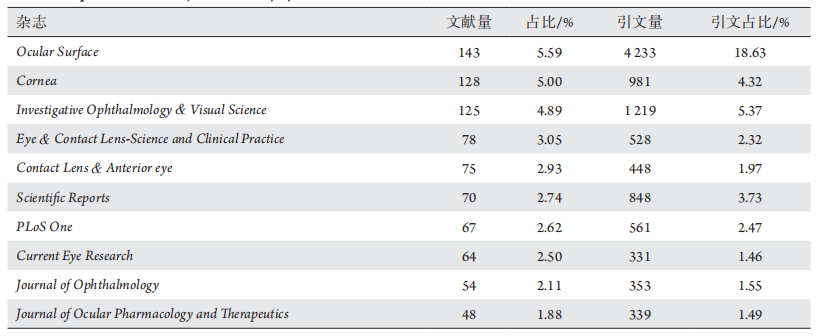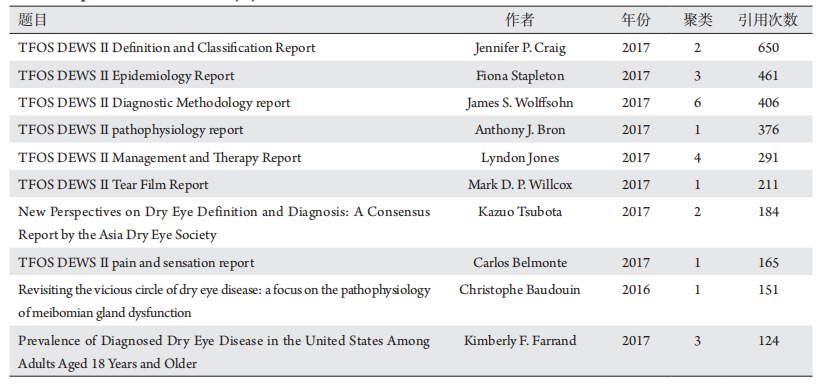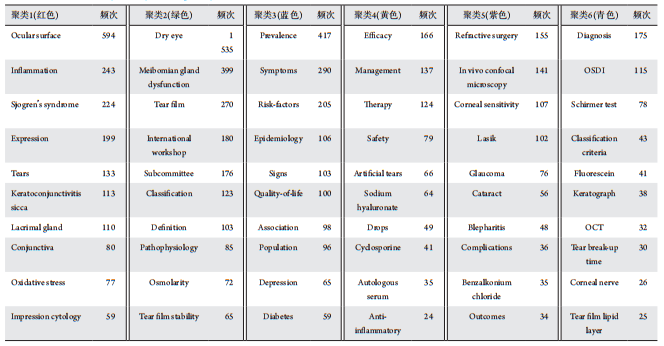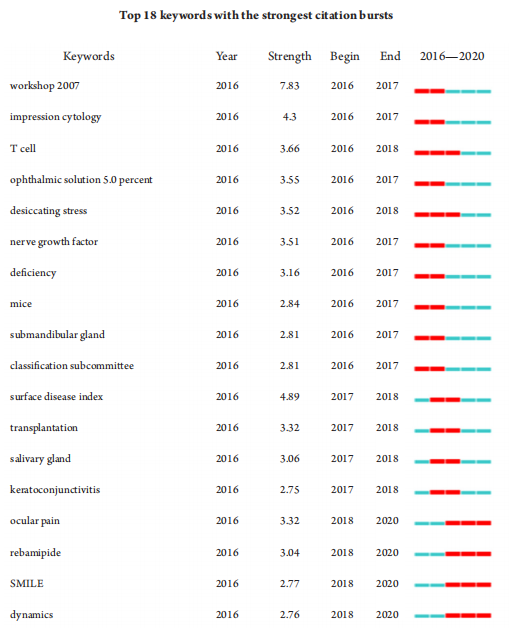1、亚洲干眼协会中国分会, 海峡两岸医药卫生交流协会眼科学专业委员会眼表与泪液病学组, 中国医师协会眼科医师分会眼表
与干眼学组. 中国干眼专家共识:定义和分类(2020年)[ J]. 中华眼科杂志, 2020, 56(6): 418-422.
Chinese Branch of the Asian Dry Eye Society, Ocular Surface and Tear Film Diseases Group of Ophthalmology Committee of Cross-Straits Medicine Exchange Association, Ocular Surface and Dry Eye Group of Chinese Ophthalmologist Association. Chinese expert consensus on dry eye: definition and classification (2020)[ J]. Chinese Journal of Ophthalmology, 2020, 56(6): 418-422.亚洲干眼协会中国分会, 海峡两岸医药卫生交流协会眼科学专业委员会眼表与泪液病学组, 中国医师协会眼科医师分会眼表
与干眼学组. 中国干眼专家共识:定义和分类(2020年)[ J]. 中华眼科杂志, 2020, 56(6): 418-422.
Chinese Branch of the Asian Dry Eye Society, Ocular Surface and Tear Film Diseases Group of Ophthalmology Committee of Cross-Straits Medicine Exchange Association, Ocular Surface and Dry Eye Group of Chinese Ophthalmologist Association. Chinese expert consensus on dry eye: definition and classification (2020)[ J]. Chinese Journal of Ophthalmology, 2020, 56(6): 418-422.
2、Song P, Xia W, Wang M, et al. Variations of dry eye disease prevalence by age, sex and geographic characteristics in China: a systematic review and meta-analysis[ J]. J Glob Health, 2018, 8(2): 020503.Song P, Xia W, Wang M, et al. Variations of dry eye disease prevalence by age, sex and geographic characteristics in China: a systematic review and meta-analysis[ J]. J Glob Health, 2018, 8(2): 020503.
3、Dana R, Meunier J, Markowitz JT, et al. Patient-reported burden of dry eye disease in the united states: results of an online cross-sectional survey[ J]. Am J Ophthalmol, 2020, 216: 7-17.Dana R, Meunier J, Markowitz JT, et al. Patient-reported burden of dry eye disease in the united states: results of an online cross-sectional survey[ J]. Am J Ophthalmol, 2020, 216: 7-17.
4、Ekundayo TC, Okoh AI. A global bibliometric analysis of Plesiomonas�related research (1990 - 2017)[ J]. PLoS One, 2018,13(11): e0207655.Ekundayo TC, Okoh AI. A global bibliometric analysis of Plesiomonas�related research (1990 - 2017)[ J]. PLoS One, 2018,13(11): e0207655.
5、Zyoud SH, Waring WS, Al-Jabi SW, et al. Global cocaine intoxication research trends during 1975-2015: a bibliometric analysis of Web of Science publications[ J]. Subst Abuse Treat Prev Policy, 2017, 12(1): 6.Zyoud SH, Waring WS, Al-Jabi SW, et al. Global cocaine intoxication research trends during 1975-2015: a bibliometric analysis of Web of Science publications[ J]. Subst Abuse Treat Prev Policy, 2017, 12(1): 6.
6、Boudry C, Baudouin C, Mouriaux F. International publication trends in dry eye disease research: A bibliometric analysis[ J]. Ocul Surf, 2018, 16(1): 173-179Boudry C, Baudouin C, Mouriaux F. International publication trends in dry eye disease research: A bibliometric analysis[ J]. Ocul Surf, 2018, 16(1): 173-179
7、van Eck NJ, Waltman L. Citation-based clustering of publications using CitNetExplorer and VOSviewer[ J]. Scientometrics, 2017, 111(2): 1053-1070.van Eck NJ, Waltman L. Citation-based clustering of publications using CitNetExplorer and VOSviewer[ J]. Scientometrics, 2017, 111(2): 1053-1070.
8、Chen C. A glimpse of the first eight months of the COVID-19 literature on Microsoft academic graph: themes, citation contexts, and uncertainties[ J]. Front Res Metr Anal, 2020, 5: 607286.Chen C. A glimpse of the first eight months of the COVID-19 literature on Microsoft academic graph: themes, citation contexts, and uncertainties[ J]. Front Res Metr Anal, 2020, 5: 607286.
9、Stapleton F, Alves M, Bunya VY, et al. TFOS DEWS II epidemiology report[ J]. Ocul Surf, 2017, 15(3): 334-365.Stapleton F, Alves M, Bunya VY, et al. TFOS DEWS II epidemiology report[ J]. Ocul Surf, 2017, 15(3): 334-365.
10、Bai Y, Ngo W, Khanal S, et al. Human precorneal tear film and lipid layer dynamics in meibomian gland dysfunction[J]. Ocul Surf, 2021, 21: 250-256.Bai Y, Ngo W, Khanal S, et al. Human precorneal tear film and lipid layer dynamics in meibomian gland dysfunction[J]. Ocul Surf, 2021, 21: 250-256.
11、Bron A J, de Paiva CS, Chauhan SK , et al. TFOS DE WS II pathophysiology report[ J]. Ocul Surf, 2017, 15(3): 438-510.Bron A J, de Paiva CS, Chauhan SK , et al. TFOS DE WS II pathophysiology report[ J]. Ocul Surf, 2017, 15(3): 438-510.
12、Belmonte C, Nichols JJ, Cox SM, et al. TFOS DEWS II pain and sensation report[ J]. Ocul Surf, 2017, 15(3): 404-437.Belmonte C, Nichols JJ, Cox SM, et al. TFOS DEWS II pain and sensation report[ J]. Ocul Surf, 2017, 15(3): 404-437.
13、Siedlecki AN, Smith SD, Siedlecki AR, et al. Ocular pain response to treatment in dry eye patients[ J]. Ocul Surf, 2020, 18(2): 305-311.Siedlecki AN, Smith SD, Siedlecki AR, et al. Ocular pain response to treatment in dry eye patients[ J]. Ocul Surf, 2020, 18(2): 305-311.
14、Ozmen MC, Dieckmann G, Cox SM, et al. Efficacy and tolerability of nortriptyline in the management of neuropathic corneal pain[ J]. Ocul Surf, 2020, 18(4): 814-820.Ozmen MC, Dieckmann G, Cox SM, et al. Efficacy and tolerability of nortriptyline in the management of neuropathic corneal pain[ J]. Ocul Surf, 2020, 18(4): 814-820.
15、Yoon HJ, Kim J, Yoon KC. Treatment response to gabapentin in neuropathic ocular pain associated with dry eye[ J]. J Clin Med, 2020, 9(11): 3765Yoon HJ, Kim J, Yoon KC. Treatment response to gabapentin in neuropathic ocular pain associated with dry eye[ J]. J Clin Med, 2020, 9(11): 3765
16、Yoon HJ, Kim J, Yang JM, et al. Topical TRPM8 agonist for relieving neuropathic ocular pain in patients with dry eye: a pilot study[ J]. J Clin Med, 2021, 10(2): 250.Yoon HJ, Kim J, Yang JM, et al. Topical TRPM8 agonist for relieving neuropathic ocular pain in patients with dry eye: a pilot study[ J]. J Clin Med, 2021, 10(2): 250.
17、Shamloo K, Barbarino A, Alfuraih S, et al. Graft versus host disease�associated dry eye: role of ocular surface mucins and the effect of rebamipide, a mucin secretagogue[ J]. Invest Ophthalmol Vis Sci, 2019, 60(14): 4511-4519.Shamloo K, Barbarino A, Alfuraih S, et al. Graft versus host disease�associated dry eye: role of ocular surface mucins and the effect of rebamipide, a mucin secretagogue[ J]. Invest Ophthalmol Vis Sci, 2019, 60(14): 4511-4519.
18、Shoji J, Inada N, Tomioka A, et al. Assessment of mucin-related gene alterations following treatment with rebamipide ophthalmic suspension in Sj?gren’s syndrome-associated dry eyes[ J]. PLoS One, 2020, 15(11): e0242617.Shoji J, Inada N, Tomioka A, et al. Assessment of mucin-related gene alterations following treatment with rebamipide ophthalmic suspension in Sj?gren’s syndrome-associated dry eyes[ J]. PLoS One, 2020, 15(11): e0242617.
19、Kobashi H, Kamiya K, Shimizu K. Dry eye after small incision lenticule extraction and femtosecond laser-assisted LASIK: meta-analysis[ J]. Cornea, 2017, 36(1): 85-91.Kobashi H, Kamiya K, Shimizu K. Dry eye after small incision lenticule extraction and femtosecond laser-assisted LASIK: meta-analysis[ J]. Cornea, 2017, 36(1): 85-91.
20、Sambhi RS, Sambhi GDS, Mather R, et al. Dry eye after refractive surgery: a meta-analysis[ J]. Can J Ophthalmol, 2020, 55(2): 99-106.Sambhi RS, Sambhi GDS, Mather R, et al. Dry eye after refractive surgery: a meta-analysis[ J]. Can J Ophthalmol, 2020, 55(2): 99-106.
21、García-Marqués JV, Talens-Estarelles C, Martínez-Albert N, et al. An emerging method to assess tear film spread and dynamics as possible tear film homeostasis markers[ J]. Curr Eye Res, 2021, 46(9): 1291-1298García-Marqués JV, Talens-Estarelles C, Martínez-Albert N, et al. An emerging method to assess tear film spread and dynamics as possible tear film homeostasis markers[ J]. Curr Eye Res, 2021, 46(9): 1291-1298
22、Wu MF, Gao H, Zhao LJ, et al. Real dynamic assessment of tear film optical quality for monitoring and early prevention of dry eye[ J]. Medicine (Baltimore), 2020, 99(31): e21494.Wu MF, Gao H, Zhao LJ, et al. Real dynamic assessment of tear film optical quality for monitoring and early prevention of dry eye[ J]. Medicine (Baltimore), 2020, 99(31): e21494.
23、Kojima T, Dogru M, Kawashima M, et al. Advances in the diagnosis and treatment of dry eye[ J]. Prog Retin Eye Res, 2020, doi: 10.1016/j.preteyeres.2020.100842.Kojima T, Dogru M, Kawashima M, et al. Advances in the diagnosis and treatment of dry eye[ J]. Prog Retin Eye Res, 2020, doi: 10.1016/j.preteyeres.2020.100842.
24、Yokoi N, Georgiev GA. Tear film-oriented diagnosis and tear film�oriented therapy for dry eye based on tear film dynamics[ J]. Invest Ophthalmol Vis Sci, 2018, 59(14): DES13-DES22.Yokoi N, Georgiev GA. Tear film-oriented diagnosis and tear film�oriented therapy for dry eye based on tear film dynamics[ J]. Invest Ophthalmol Vis Sci, 2018, 59(14): DES13-DES22.

